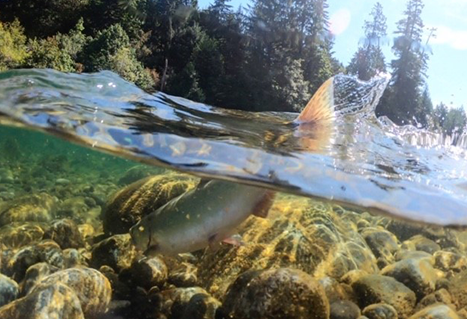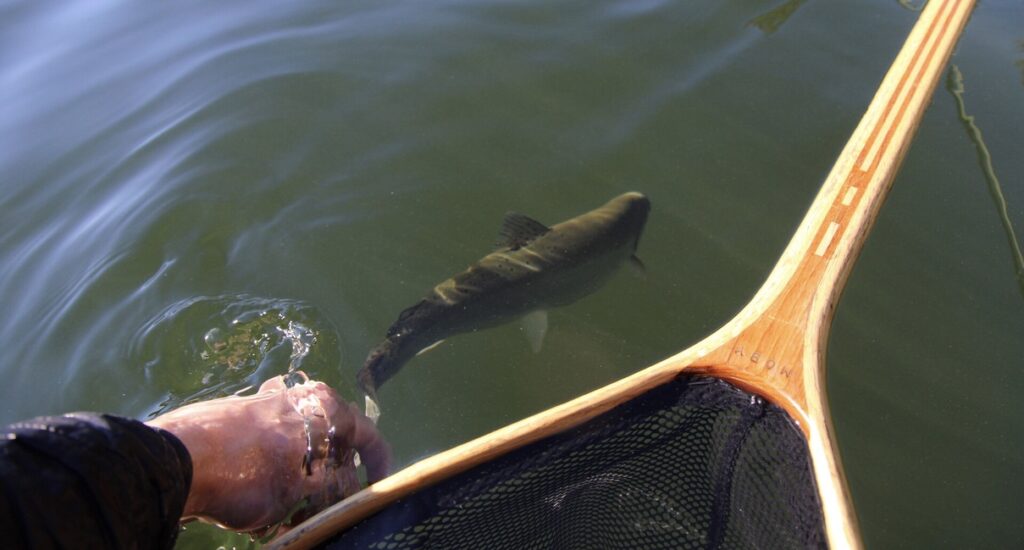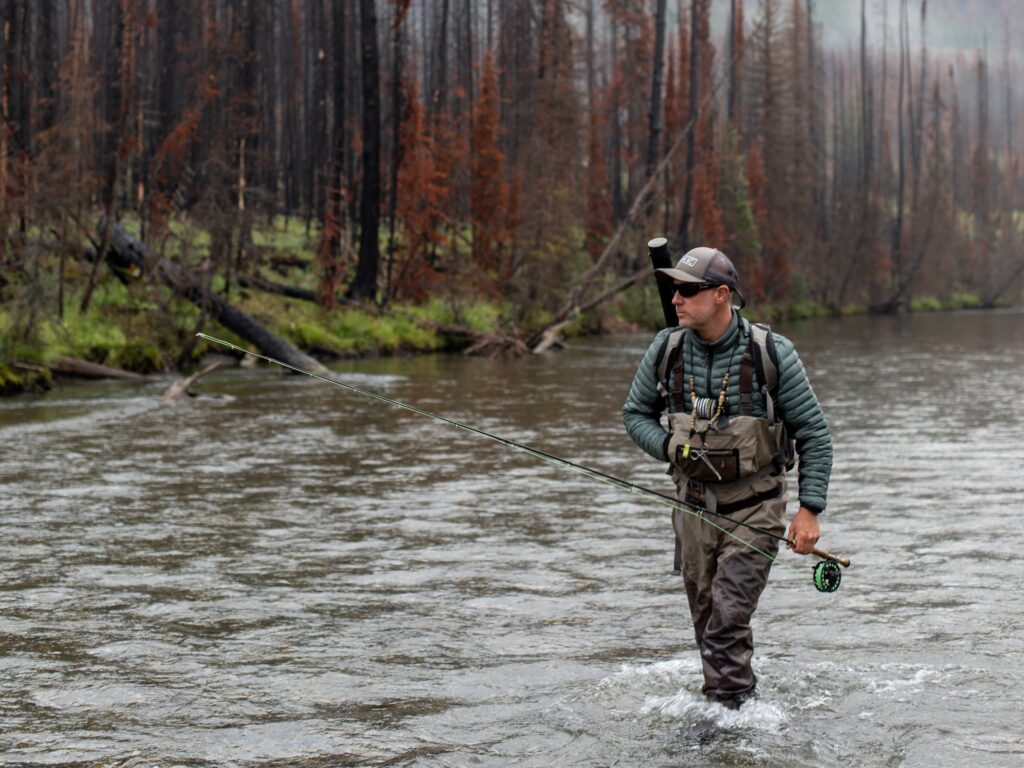What are drought conditions?
British Columbia continues to face unpredictable and extreme weather conditions including extended summer droughts. In general, many areas of the province are seeing less precipitation at critical times, although at other times rain and snow events can be extreme. Less snowfall in the winter means less meltwater in streams and lakes. This, in addition to less rain in the summer and associated increased water demand by the farming industry and municipalities, results in streams that can fall to critically low flow levels in some areas.
Summer 2023 is proving to be yet another record breaker for weather conditions in the province. An unusually dry spring and no recent rain has led to several areas already hitting Level 5 drought conditions – the highest level on the provincial scale and a level at which adverse impacts to socio-economic or ecosystem values are almost certain. Geographic drought level information, including stream-flow data, can be viewed on the BC Drought Information Portal.

Provincial response
British Columbia has developed a drought response plan for fisheries management to address the increasingly frequent drought conditions experienced in streams around much of the province. This plan lays out fish protection guidelines that reflect severity of drought, water supply, and water temperatures. Suggested tools include more conservative angling regulations during high-stress times; water-use planning to prioritize fish needs where there are multiple users; and angling closures. The plan proposes maximum water temperature thresholds where recreational fisheries should be closed if these thresholds are exceeded.
Due to persistent year-to-year high frequency of thermal events, the provincial response has been to proactively close fisheries, such as on the Cowichan River where July-August stream temperatures get as high as 25°C due to surface heating of Cowichan Lake. Proactive full-fishing summer closures on Vancouver Island include most streams on the southern half of the island. Please refer to the Region 1 regulations for full details.
Other regions are also monitoring both flow and water temperature closely to ensure thresholds for fish are not surpassed. Anglers should check regulations for all regions before fishing to ensure no in-season regulatory changes have been made.
2023 In-Season Regulatory Changes
Region 4
No Fishing from 2:00 pm until midnight, August 2, 2023 until further notice in the following waterbodies: Michel Creek, Morrissey Creek, Lizard Creek, Coal Creek, Sand Creek, St. Mary River (lower), all streams in MUs 4-3 to 4-9 (other than the mainstems of the Columbia and Kootenay Rivers).
Impact of drought on fish
Of course, there is the obvious: fish need water. Drought means less water. However, drought conditions – especially in summer months, when temperatures are elevated – are more complicated than just water availability.
In general, reduced water levels mean reduced availability of physical habitat. Flowing water in streams can in extreme cases be reduced to a series of isolated pools, where key riffle habitats dry up and no longer capture oxygen through aeration. Reduced lake levels mean less volume, compressing habitat for all species; this forces predators and prey to share smaller thermal refugia, and competition for space increases. Reduced water levels also mean that waterbodies heat up faster. As water increases in temperature, it has a lower capacity to retain dissolved oxygen. At the same time, elevated temperatures increase metabolic rates in organisms, which increases the demand for oxygen. For animals like fish that breathe via gills, this can be disastrous. Finally, many waterbodies are also approaching or surpassing maximum temperature thresholds for biological processes in fish. Fish are ectotherms. This means they cannot regulate their body temperature, and body temperature reflects that of their watery environment.
When water heats up to a certain level (~20oC average weekly maximum temperature for many trout species), fish begin to experience physiological stress. The more prolonged and severe the temperature elevation, the more likely for the impacts to result in death. Some species are more sensitive than others to warm water. For example, char are cold-water specialists, and their tolerance is lower than that of trout.
Fish habitats in B.C. are diverse; they range from glacier-fed streams that remain cold year ’round to low-lying systems where water temperatures vary widely from summer to winter. Vulnerability to heat and drought also varies depending on habitat. Lake-headed and snow-fed streams, as well as shallow lakes (especially in southern regions) are generally more vulnerable to summer heat than large, deep lakes and glacial-fed streams.

Summer heat survival options in rivers and streams
Summer heat survival options for fish may be different for streams compared to lakes. Assuming water continues to flow in a stream, water movement generally keeps water mixed and oxygenated (although a loss of riffles reduces this capacity), but with a more uniform temperature except where cold water seepages from springs occur. Fish will seek refuge in proximity to these seepages and in deeper, shaded pools to reduce energy expenditure. This can result in very “clumped” fish distributions. Water temperatures in some streams can increase quickly to (sub-)lethal levels when temperatures stay high. However, they are also more responsive than lakes when air temperatures drop again, returning to tolerable levels for fish.
As the summer sun heats lake surfaces, waters stratify, where the warmest waters settle in the shallow surface layer while the coolest waters remain in the deepest layer. This stratification intensifies as summer progresses, with less and less mixing between the two layers. The surface layer maintains high oxygen levels due to wind action. The deep, cool layer where fish may seek refuge becomes depleted of oxygen over the summer months due to use by fish and other organisms, as well as lack of mixing with the surface. Over the summer, these two layers may force an increasingly narrow wedge between the two layers for cool-water fish like trout trying to balance temperature and oxygen needs. In extreme cases, this can result in a summer fish kill. Falling temperatures in the autumn restore mixing, and deeper layers are usually replenished with oxygen.


How can recreational anglers help?
As recreational anglers, we can be proactive and take additional steps to help protect fish when summer temperatures start to climb, prior to provincial measures being invoked. When temperatures are elevated and oxygen is less available, fish become physiologically stressed. Additional activity – such as fighting on the end of a line, air exposure, and handling – only increases this stress. For the fish, this can mean longer recovery times, and increased likelihood of delayed mortality.
Anglers can reduce the stress load on fish in elevated temperature conditions in several ways. Particularly if you practice Catch & Release, consider the following:
- Before you head out, look up current conditions using Water Survey of Canada real-time temperature information and drought conditions in your area using the Drought Information Portal
- Bring a low-cost fishing thermometer if you are planning to fish a stream/river, especially during extreme heat conditions
- Take extra care in minimizing air exposure, and avoid taking photos of fish to reduce handling
- Be selective on when and where you fish:
- Fish in early morning and evening periods, when air temperatures are lower
- Avoid fishing in streams where temperatures exceed 16oC (for char fisheries) and 23oC (when not targeting char)
- Avoid fishing in shallow lakes where temperatures could exceed 20oC at depth
- Avoid or limit your time fishing isolated pools in streams where water levels have dropped drastically; these pools can act as refugia, providing the only habitat in some systems, and may concentrate fish, making them more vulnerable to angling
- Minimize fight time to limit fish exertion
- Consider delaying fishing vulnerable waterbodies until later in the season.
While relevant for the well-being of all fish, these recommendations are particularly pertinent for wild fish to support conservation objectives.

Additional Information:
The Keep Fish Wet initiative provides excellent information on best angling practices, as well as information on increased temperatures and impacts on fish.
The Province provides updated links to droughts and protective measures around the regions here.
Author: Sue Pollard, Freshwater Fisheries Society of BC.
